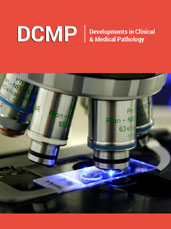- Submissions

Full Text
Developments in Clinical & Medical Pathology
Gestational Diabetes Mellitus: Pathophysiology and Risk Factors
Sununta Youngwanichsetha*
Department of Nursing, Prince of Songkla University, Thailand
*Corresponding author: Sununta Youngwanichsetha, RN, PhD, Assistance Professor, Faculty of Nursing, Prince of Songkla University, 90112, Hat Yai, Songkhla, Thailand
Submission: April 14, 2018;Published: April 20, 2018

ISSN:2690-9731 Volume1 Issue2
Introduction
Prevalence of gestational diabetes mellitus (GDM) is increasing among pregnant women worldwide. Understanding of GDM pathophysiology and risk factors is helpful to prevent its complications. Known risk factors of GDM are genetic and unhealthy behaviors. Genetic risk factor is associated with pancreatic beta cell dysfunction and impaired carbohydrate and fat metabolism. In addition, unhealthy behaviors including dietary pattern and lack of exercise are known to promote development of diabetes. Overeating of unhealthy diet causes obesity, insulin resistance, and endothelial cell dysfunction. Food containing high sugar, fructose corn syrup, trans fat and advanced glycation end products (AGEs) are associated with insulin resistance and impaired insulin signaling. As a result, elevated of blood glucose glycated hemoglobin, and dyslipidemia occur [1]. Moreover, reduction of adipokines secreting from adipose tissue is associated with insulin resistance, imbalance of glucose production, dysfunction of lipid metabolism, development of atherosclerosis and diabetes.
Moreover, lack of regular exercise lead to accumulation of adipose tissue and visceral fat that suppress insulin sensitivity. Reduction in cellular uptake of glucose results in enlargement adipocyte and adipose tissue promoting insulin resistance. During pregnancy, diabetogenic effect occurs in order to preserve plasma glucose for fetal development. Human placental lactogen, cortisol, estrogen, progesterone, and insulinase work as insulin antagonist [2]. Therefore, beta cells in the pancreas produce more insulin. However, women with overweight and obesity cannot excrete sufficient insulin because of prior insulin resistance. They are more likely to develop GDM during the second trimester of pregnancy. Manifestation of pathophysiology of GDM among pregnant women is associated with degree of insulin resistance and endothelial cell dysfunction [3].
Prolonged insulin resistance leads to hyperinsulinemia state and vascular damage both macrovascular and microvascular resulting in reduction of placental blood flow. As a result, pregnancy complicated with GDM is often affected with abortion, preterm labor, and hypertensive disorders [4,5]. Research evidence shows that elevated of triglycerides increases risk for development of preeclampsia among pregnant women with GDM. Newborn complications are large fetus, malformation, or dead fetus. Neonatal hypoglycemia is common among infants born to mothers with GDM. Knowing of GDM risk factors and pathophysiology is useful to prevent its complications [6]. Reproductive women should be advised to prevent GDM by empowering of healthy nutrition and doing regular exercise. Promotion of consumption of food rich in protein, iron, folate, and antioxidant compounds should be the focus. Avoiding of food containing high sugar and trans fat should be promoted in order to reduce insulin resistance and endothelial cell damage.
References
- Donazar EM, Lopez-del BC, Martinez-Gonzalez MA, Basterra-Gortari FJ, de Irala J, et al. (2018) Soft drink consumption and gestational diabetes risk in the SUN project. Clinical Nutrition 37(2): 638-645.
- Fasshauer M, Bluher M (2015) Adipokines in health and disease. Trends in Pharmacological Science 36(7): 461-470.
- Harlev A, Wiznitzer A (2010) New insights on glucose pathophysiology in gestational diabetes and insulin resistance. Current Diabetes Reports 10(10): 242-247.
- Kleinberger JW, Maloney KA, Pollin TI (2016) The genetic aechitecture of diabetes in pregnancy. American Journal of Perinatology 33(13): 1319-1326.
- Ruchat SM, Mottola MF (2013) The important role of physical activity in the prevention and management of gestational. Diabetes and Metabolism Research and Reviews 29(5): 334-346.
- Ruiz-Palacios M, Ruiz-Alcaraz AJ, Sanchez-Campillo M, Larque E (2017) Role of insulin in placental transport of nutrients in gestational diabetes mellitus. Annals of Nutrition and Metabolism 70(1): 16-25.
© 2018 Sununta Youngwanichsetha. This is an open access article distributed under the terms of the Creative Commons Attribution License , which permits unrestricted use, distribution, and build upon your work non-commercially.
 a Creative Commons Attribution 4.0 International License. Based on a work at www.crimsonpublishers.com.
Best viewed in
a Creative Commons Attribution 4.0 International License. Based on a work at www.crimsonpublishers.com.
Best viewed in 







.jpg)






























 Editorial Board Registrations
Editorial Board Registrations Submit your Article
Submit your Article Refer a Friend
Refer a Friend Advertise With Us
Advertise With Us
.jpg)






.jpg)














.bmp)
.jpg)
.png)
.jpg)










.jpg)






.png)

.png)



.png)






